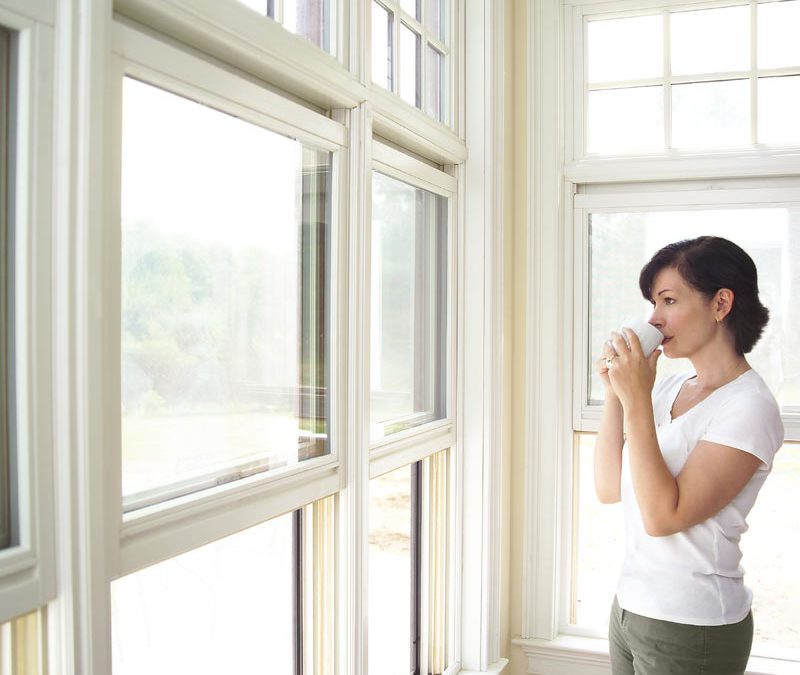Looking for new replacement windows? Depending on the season, windows allow natural light to shine in during the day and lets the cool air in at night. Finding the perfect window type for your home isn’t easy and because there are so many different types of windows and styles to choose from, it’s very important to specify what it is you want and need from them before installation begins.
1. Single-Hung Windows
Single hung windows are one of the most common types of windows that you’ll see on any home today. The major difference between a single hung window and double hung windws is how the different window sections move. With single hung windows, the bottom window panel or lower sash moves up and down, and the upper sash remains stationary. This means that when you open the window, the upper sash is covered on the inside.
2. Double-Hung Windows
This type of window has two sashes that slide vertically up and down in the frame. They can open wide from either the top or the bottom, but they remain inside the frame so they don’t protrude out to the exterior or interior of the house. On a single-hung window, only the bottom part of the window operates while the top part remains stationary.
3. Casement Windows
Casement windows are built with a hinge in their construction. Instead of sliding open like double or single hung windows, they swing out to the side or up to open. This allows the window to be constructed of solid glass and offers a less obstructed view overall. These hinged windows operate by a turn of a crank in an operating mechanism. They are energy-efficient, ventilating style windows.
4. Awning Windows
These windows are hinged at the top and open outward. This allows for sufficient ventilation. Awning windows are often used with other window styles and are easy to open and close. They also have a few advantages, one being they are considered waterproof or weather resistant, improved insulation, enhanced views and security.
5. Picture Windows
These windows are typically in the living room and are considered combination windows because you can add different types of windows on both sides of a picture window. They are an ideal solution for showcasing your beautiful view.
6. Transom Windows
Want a decorative accent window, that let’s light in your front door? Look no further, Transom Windows are exactly what you need. These windows help break up space and add a unique design focal point. They’re typically a semicircle shape, but can be any shape.
7. Sliding Windows
These windows have two sections that are usually made from single windows. One section slides horizontally over-top of the other to open or close. Only half the space of a sliding window can be used for ventilation purposes. Sliding windows are typically used in homes with short walls because they don’t take up as much vertical space.
8. Bay or Bow Windows
These windows come in a set of three, which are angled out and away from the house. The window in the center is generally fixed and larger than the side windows (which are called flankers). Bay windows open up your space, allowing more light to come in. The difference between a Bay and Bow is the bow usually has four or five openings.
9. Storm Windows
These are seasonal exterior windows that are installed right in the same frame as your current windows. They are an added layer of protection for those colder months. They are flat panels with no breaks and are highly effective at preventing drafts and heat loss. Compared to new replacement windows, storm windows are very affordable.
10. Egress Windows
These windows are designed for safety more than anything else. They are the windows that provide an escape route when an emergency such as a fire, for example, prevents you from exiting through a door.
11. Garden Windows
These are mini bay windows that are meant for showcasing plants. They’ve earned their name because they act like little tiny greenhouses that protrude from the inside of your home. Garden windows can hold many different plants, and many will even accommodate shelves so that you can add several plants per window.
12. Glass Block Windows
These windows are most often considered accents and added to a section of the home to increase light flow. Most commonly, glass block windows are frosted or adorned with a patterned design, which provides simultaneous light and privacy. This makes them ideal for use in bathrooms, basements, and other private spaces.
13. Hopper Windows
These windows open from the top and usually crank open to tip down. They make efficient use of compact spaces, which is why they’re commonly found in basements. They’re also known for providing excellent insulation, because they seal up against the frame when closed all the way. They open with an upward slant, which is especially beneficial for basements or first floor rooms, since this keeps debris from entering a home. Hopper windows are also commonly used in bathrooms commonly for insulation.
14. Jalousie Windows
These windows are the unique windows that you’ll find on many older homes around the world. They are split into many different slats of metal or glass. The windows open like a set of blinds. Simply crank the lever and the slats tilt to the side, which creates a series of gaps for air to flow through. They were common years ago because of their easy maintenance and affordability. Today, jalousie windows are still used in some homes in warmer climates, but they don’t provide enough insulation to justify use on homes in cooler climates.
15. Round Circle Windows
Where you have a round, half round, elliptical, or oval—the round window, they all are in the round window category. Round windows give your space a pinch of historical decor, such as Victorian or Gothic era structures.
16. Skylight Windows
Not all skylight windows open. Most remain closed and only serve the purpose of increasing sunlight into your space, as well as showcasing a picturesque night sky. If you have limited wall space and want more natural light to come in, adding a skylight may be your best option. It’s essentially a window on your roof.
17. Custom Windows
These windows are custom crafted from dimensions that you give to the home improvement professional. Custom windows can be as large as you want them to be. Explore the opportunities.
Frame Materials
Let’s not forget about framing your windows. If you need to purchase full replacement windows, there are a few frames to check out before settling on one. Wood window frames and all-vinyl are very popular, however you may find that all-aluminum and fiberglass frames suite your needs.
Wooden Frames
Most are solid wood, though some may include composite materials (e.g., plastic with wood fibers embedded in it). You can choose from a variety of hardware finishes, allowing you to pick a style that matches your home.
To avoid seeing your new window frames rot, you’ll want to consider an alternative to solid wood. Vinyl windows are the most affordable choice, or you can get real wood windows covered by an aluminum skin (“cladding”) on the exterior. The cladding comes factory painted in your color of choice, and that finish is guaranteed for 20 years—a good three to four times longer than exterior paint applied to solid wood windows. You’ll pay about 15% to 20% percent more for aluminum-clad than unclad wood.
Vinyl Frames
They’re typically the least expensive and do not need to be painted or stained, but most are white and usually they can’t be painted. There are also fewer hardware options. Among casement windows, there was little difference between vinyl and wood frames.
Fiberglass Frames
They’re relatively new. While you won’t have to paint them, they can be painted. Fiberglass needles embed the plastic to make it stronger and stiffer, but there aren’t many brands available.
Ways to Save
If you are looking for a way to save and your existing frames and sills are still in good shape, you will save money on both materials and labor by using partial replacement units. Replacement units or “pocket replacements” fit into the existing frame. If the existing frames and sills are not strong enough, you will need full replacement windows.
There are federal income tax credits available for Energy Star qualified windows. Some of these programs offer rebates or incentives that are available here: https://www.energystar.gov/about/federal_tax_credits

